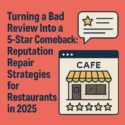Every restaurant gets a bad review eventually. Maybe someone waited too long, got the wrong order, or just had an off night. In 2025, how you respond matters far more than the review itself.
Thanks to platforms like Google, Yelp, and OpenTable, customer feedback is now public — and permanent. But with the right strategies, you can flip that negative feedback into a golden opportunity to showcase your professionalism, responsiveness, and commitment to great service.
Why Responding to Negative Reviews Is Critical
- 73% of diners say they’re more likely to visit a restaurant that professionally responds to negative reviews.
- Responding shows future guests that you care and are willing to improve.
- Search engines prioritize active listings — reviews + responses = higher visibility.
Step-by-Step: How to Handle a Negative Review the Right Way
1. Breathe, Then Read
Don’t respond emotionally. Read the review carefully. Is it legitimate? Does it point to a fixable issue? Separate fact from frustration.
2. Respond Promptly — But Professionally
Use empathy. Thank the reviewer for their feedback, acknowledge the issue, and offer to make it right. Here’s a sample template:
“Hi [Name], thank you for your honest feedback. We’re sorry to hear about your experience — it’s certainly not the standard we aim for. We’d love a chance to make it right. Please reach out to us directly at [contact info] so we can learn more and invite you back.”
3. Don’t Argue in Public
Even if the review is unfair, keep your response calm and kind. Future guests are watching how you behave — not just the original reviewer.
4. Take the Conversation Offline
Offer a way for the guest to contact you privately. This helps de-escalate and gives you the chance to turn the situation around without airing more details online.
5. Learn from the Feedback
If multiple reviews mention slow service or bland food, it’s not a coincidence — it’s a pattern. Use reviews to uncover blind spots and improve.
Proactive Reputation Repair Strategies
1. Encourage More Positive Reviews
The best way to fix your average rating is to drown out the old with fresh, positive feedback. Tools like ReviewBoost help direct happy customers to leave reviews on Google, Yelp, and OpenTable — while quietly catching unhappy ones before they go public.
2. Use In-House Signage and Staff Scripts
Train your team to say, “If you enjoyed your experience, we’d love a quick review — you can scan the code here.” Keep it casual and polite.
3. Set Up Automated Follow-Ups
With platforms like OpenTable or SMS tools, you can automatically ask recent guests to leave a review. The key is consistency.
4. Track Your Reputation Over Time
Use tools like Google Alerts, ReviewBoost, or even a spreadsheet to track trends, top complaints, and positive themes.
5. Celebrate Wins with Your Team
Share positive reviews in team meetings. Recognize staff members by name when they’re mentioned. This boosts morale and encourages great service.
Real Story: A Comeback in Cleveland
One downtown restaurant had a 3.2-star average and was losing guests fast. With help from a review management system, staff coaching, and a new QR code campaign, they pushed their average up to 4.3 stars in just 90 days. Even better — they turned three 1-star reviewers into repeat customers who left glowing 5-star follow-ups after a personal apology and comped return visit.
Key Takeaways for 2025
- Bad reviews happen — it’s how you respond that defines your brand.
- Professional, empathetic replies can rebuild trust and turn critics into advocates.
- Automating your review funnel helps ensure more great experiences get seen.
- Investing in reputation repair is one of the smartest marketing moves you can make.
Call to Action
Is your restaurant recovering from bad reviews?
You’re not alone — and you don’t have to fix it alone either. With the right tools and a plan, your reputation can be your biggest asset. Try ReviewBoost free for 14 days and see how easy it is to bounce back stronger.








Sorry, comments are closed for this post.